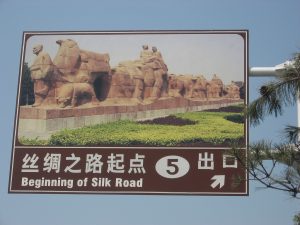COVID-19 has added a new twist to China’s declarations of reviving the Silk Roads for the 21st century. As China continues to relax restrictions on domestic mobility, this year’s October Golden Week national holiday is likely to mark an important turning point in the economic fortunes of many of the country’s regional cities and periphery regions.
Since 2013, China’s Belt and Road Initiative has been declared as a revival of the Silk Roads for the 21st century. This has led to a dramatic uptick in Silk Road history and heritage projects, both in China and internationally. Many of those countries wanting to participate in Belt and Road collaborations have celebrated the core tenets of Silk Road history: exchange, trade, friendship, and dialogue.
In China, COVID-19 interrupted the development of a rapidly flourishing industry trading in Silk Road histories. Over recent years, various cities and provinces have been investing heavily in cultural infrastructure projects in order to secure visibility in the prestige economy of the Silk Road.
Invented in the late 19th century, the concept of the Silk Road has become one of the most compelling, enigmatic geocultural imaginaries of the modern era, reaching global fame in the post-Cold War era. But as China enthusiastically embraces the Silk Road on the back of the Belt and Road, it now provides a powerful platform for the Communist Party to communicate particular ideas to domestic audiences about the country’s place in world history. Fostering pride in past glories and achievements is also about legitimizing ambitions for the future, and securing support for 21st century Silk Roads among modern-day risks and challenges. In the cultural revival now underway in China, we are also seeing the emergence of a Silk Road geocultural nationalism. Central to this has been domestic tourism.
Prior to COVID-19 restrictions on movement, Xi’an, Dunhuang, Guangzhou, Suzhou, Lanzhou, and Quanzhou were among those cities promoting themselves as key hubs along the Silk Roads, whether maritime or overland. The October Golden Week holiday has witnessed a rejuvenation of this cultural economy, as COVID related restrictions continue to be lifted. Tourism is considered a significant component of the government’s new “dual circulation” economic strategy, with the domestic sector taking a leading role, supplemented by the international market. In the days leading up to the Golden Week, the government’s Ministry of Culture and Tourism reduced restrictions on the country’s tourist locations by adjusting maximum carrying capacities upwards from 50 percent to 75 percent. Incentives including ticket fee reduction and exemptions, as well as tourist coupons, have been introduced throughout the country to revive its cultural tourism industry.
In recent weeks, the city of Xi’an has hosted the 2020 World Culture and Tourism Forum, focusing on strategies for post-epidemic recovery. A key priority of the event was the promotion of Silk Road themed activities and attractions across Gansu province.
Likewise, in late September, the city of Lanzhou led an initiative involving 19 other cities along the Yellow River to form a cultural tourism alliance. Lanzhou continues to utilize Silk Road narratives as part of a strategy to become the principal hub of tourism across northwest China. To attract visitors during the Golden Week, the “Lanzhou Noodle Festival” featured performances that conveyed the city’s importance for “a Silk Road that crosses 3,000 miles and Chinese civilization of 8,000 years.”
A “Train Tour Across the Western Region” developed by a number of provincial governments, including those of Sichuan and Xinjiang, has also been branded as “connecting the Overland and Maritime Silk Roads, boosting dual circulation.” Designed to link up 12 provinces in the western part of China, the route forms a tourism circuit that celebrates cross-region connectivity. Further Silk Road projects are scheduled to come online over the coming months. The Xi’an Silk Road International Film Festival, and Silk Road International Micro-Video Exhibition in Lanzhou are among the initiatives planned for October.
The massive scale of domestic tourism in China means the sector has become a space of fierce competition, as cities and regions vie for the economic dividends of tens of millions of travelers. Its steady resumption also means reviving those public diplomacy messages centered around China’s histories of connectivity, trade, and exchange, whether they be in the making in the 21st century, or in the distant past.
Chen Zhixin is a Ph.D. candidate at the University of Western Australia working on the Belt and Road as infrastructural power.
Tim Winter is an ARC Professorial Future Fellow on heritage diplomacy and the Belt and Road, and the author of “Geocultural Power: China’s quest to revive the Silk Roads for the 21st century” (University of Chicago Press, 2019).

































